Advertisement
Understanding Fascia: Why You Feel Tight + How To Release Tension

Back when I was in school, it was taught the white "film" on cadavers (fascia) was non-contractile and non-specific. But we know now that fascia is, without argument, alive and has contractile properties. So if we accept that fascia is unequivocally connected throughout our body and that it is indeed "alive,” how do we exercise to affect the fascial system?
Fascia is water and glycosaminoglycans, a technical term for carbohydrate or sugar. To optimize health, pain management and injury avoidance, fascia must be well-hydrated. The water trapped inside the tubes of fascia move up and down a pressure gradient from high to low, pulsing fascia like a receding wave. Through this pressure gradient, fascia is affected by all movement and hydration.
If we always move in familiar patterns, fascia molds and secures itself into those repeated patterns (even more so if there is insufficient water available). For example, sitting at a desk often has the shoulder blades sitting lateral (or out) on the rib cage. If the fascia isn't released and trained into a retracted position, the shoulder blades will lock down and forward into this faulty pattern, directly affecting movement of the neck and arms.
Fascia can be best released with hands-on manual therapy or through stretch-and-hold techniques. Here are areas it's crucial to stretch our fascia—especially if you're sitting all day—and how to do it:
1. Shoulder Fascia
For shoulder fascia stretches, stretch above the shoulder at the neck and below the shoulder, at the arm. Releasing some tension above and below the shoulder first will allow a new and more optimal fascia tension to ensue. Hold fascia stretches for 30-90 seconds. If it's too hard to hold the stretch, repeat at intervals until you've accumulated two minutes of stretching.
2. Neck Fascia

Fascia needs resistance to release. It seems counter intuitive, but pressing into a stretched position against applied resistance allows fascia to release better.
In the example to the left (posterior fascia neck stretch), the chin is dropped to the opposite shoulder and the hand holds the head. Press the head into your hand, not so intensely as to cause pain, but enough to feel the fascia slightly "burn." To better enhance the tension of the fascia, tuck the arm behind your back and keep it reaching across. Once released, turn your head to both sides and note any increase in range of motion on the side that was stretched. Stretch both sides, but add extra time to the more restricted side.
3. Arm Fascia

To stretch the arms, a doorway stretch is great (just remember to add a few pounds of pressure applied from the hand and arm into the wall or door frame). Hold for the 90-120 seconds, then compare the difference in your two arms.
If you'd rather not use a door to stretch, you can try a standing fascial arm stretch, which will be enhanced by the tension you create through the limb (your entire body is engaged). Press the back heel hard to the floor with as much pressure as you can muster. Press the arm on the same side as the leg downward with intense pressure and a flexed wrist. Reach the arm that needs fascial release on a 60-degree angle up and back with wrist flexed. Follow the direction of the arrows with intense pressure and breathe deep into the held position for a 1-2 minute interval.
Remember that fascia as we understand it today is mapped along lines of tension. When you engage the fascia in a stretch, be sure to put the entire body into tension and mind the breath. With breath, our diaphragm descends and ascends. With the diaphragm's attachment to our lower ribs, we can use deep breathing to enhance all fascial tension-stretches. Compare and contrast stretched and unstretched sides until you feel symmetry.
Watch Next
Enjoy some of our favorite clips from classes
Enjoy some of our favorite clips from classes
What Is Meditation?
Mindfulness/Spirituality | Light Watkins
Box Breathing
Mindfulness/Spirituality | Gwen Dittmar
What Breathwork Can Address
Mindfulness/Spirituality | Gwen Dittmar
The 8 Limbs of Yoga - What is Asana?
Yoga | Caley Alyssa
Two Standing Postures to Open Up Tight Hips
Yoga | Caley Alyssa
How Plants Can Optimize Athletic Performance
Nutrition | Rich Roll
What to Eat Before a Workout
Nutrition | Rich Roll
How Ayurveda Helps Us Navigate Modern Life
Nutrition | Sahara Rose
Messages About Love & Relationships
Love & Relationships | Esther Perel
Love Languages
Love & Relationships | Esther Perel












